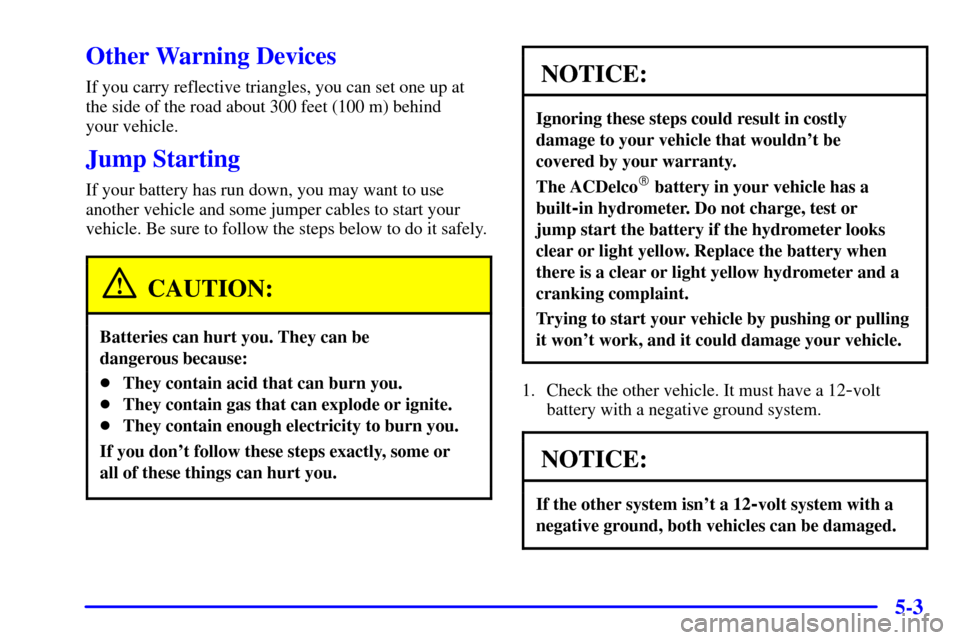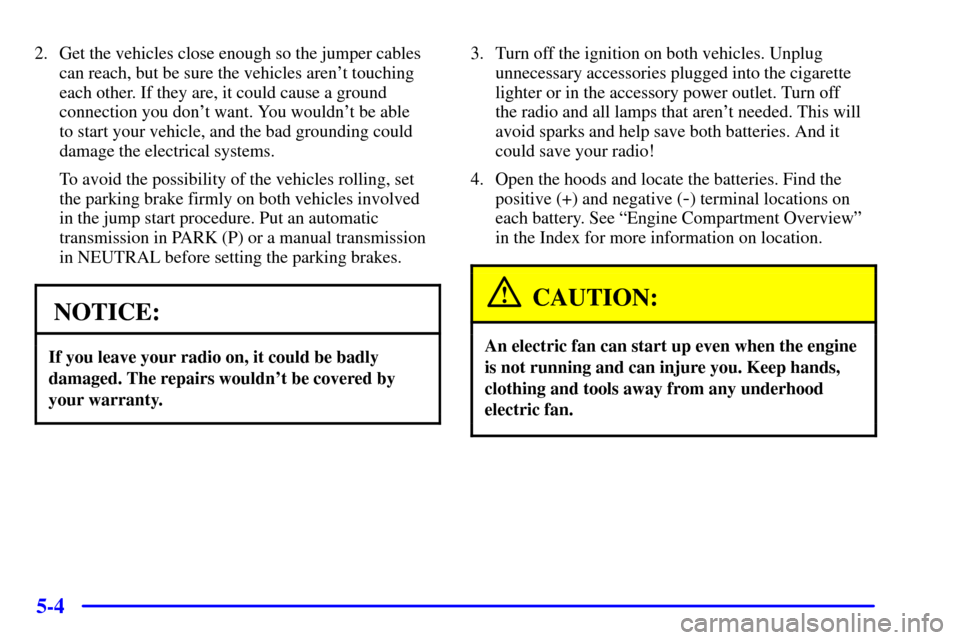Page 211 of 356
5-
5-1
Section 5 Problems on the Road
Here you'll find what to do about some problems that can occur on the road.
5
-2 Hazard Warning Flashers
5
-3 Other Warning Devices
5
-3 Jump Starting
5
-8 Towing Your Vehicle
5
-9 Engine Overheating5
-12 Cooling System
5
-22 If a Tire Goes Flat
5
-23 Changing a Flat Tire
5
-35 Compact Spare Tire
5
-36 If You're Stuck: In Sand, Mud, Ice or Snow
Page 213 of 356

5-3
Other Warning Devices
If you carry reflective triangles, you can set one up at
the side of the road about 300 feet (100 m) behind
your vehicle.
Jump Starting
If your battery has run down, you may want to use
another vehicle and some jumper cables to start your
vehicle. Be sure to follow the steps below to do it safely.
CAUTION:
Batteries can hurt you. They can be
dangerous because:
�They contain acid that can burn you.
�They contain gas that can explode or ignite.
�They contain enough electricity to burn you.
If you don't follow these steps exactly, some or
all of these things can hurt you.
NOTICE:
Ignoring these steps could result in costly
damage to your vehicle that wouldn't be
covered by your warranty.
The ACDelco� battery in your vehicle has a
built
-in hydrometer. Do not charge, test or
jump start the battery if the hydrometer looks
clear or light yellow. Replace the battery when
there is a clear or light yellow hydrometer and a
cranking complaint.
Trying to start your vehicle by pushing or pulling
it won't work, and it could damage your vehicle.
1. Check the other vehicle. It must have a 12-volt
battery with a negative ground system.
NOTICE:
If the other system isn't a 12-volt system with a
negative ground, both vehicles can be damaged.
Page 214 of 356

5-4
2. Get the vehicles close enough so the jumper cables
can reach, but be sure the vehicles aren't touching
each other. If they are, it could cause a ground
connection you don't want. You wouldn't be able
to start your vehicle, and the bad grounding could
damage the electrical systems.
To avoid the possibility of the vehicles rolling, set
the parking brake firmly on both vehicles involved
in the jump start procedure. Put an automatic
transmission in PARK (P) or a manual transmission
in NEUTRAL before setting the parking brakes.
NOTICE:
If you leave your radio on, it could be badly
damaged. The repairs wouldn't be covered by
your warranty.
3. Turn off the ignition on both vehicles. Unplug
unnecessary accessories plugged into the cigarette
lighter or in the accessory power outlet. Turn off
the radio and all lamps that aren't needed. This will
avoid sparks and help save both batteries. And it
could save your radio!
4. Open the hoods and locate the batteries. Find the
positive (+) and negative (
-) terminal locations on
each battery. See ªEngine Compartment Overviewº
in the Index for more information on location.
CAUTION:
An electric fan can start up even when the engine
is not running and can injure you. Keep hands,
clothing and tools away from any underhood
electric fan.
Page 217 of 356
5-7
9. Connect the other end of
the negative (
-) cable at
least 18 inches (45 cm)
away from the dead
battery, but not near
engine parts that move.
The electrical connection
is just as good there, and
the chance of sparks
getting back to the
battery is much less.10. Now start the vehicle with the good battery and
run the engine for a while.
11. Try to start the vehicle that had the dead battery.
If it won't start after a few tries, it probably
needs service.
NOTICE:
Damage to your vehicle may result from electrical
shorting if jumper cables are removed incorrectly.
To prevent electrical shorting, take care that
the cables don't touch each other or any other
metal. The repairs wouldn't be covered by
your warranty.
Page 284 of 356

6-38
Battery
Your new vehicle comes with a maintenance free
ACDelco� battery. When it's time for a new battery,
get one that has the replacement number shown on the
original battery's label. We recommend an ACDelco
battery. See ªEngine Compartment Overviewº in the
Index for battery location.
WARNING: Battery posts, terminals and related
accessories contain lead and lead compounds, chemicals
known to the State of California to cause cancer and
reproductive harm. Wash hands after handling.
Vehicle Storage
If you're not going to drive your vehicle for 25 days
or more, remove the black, negative (
-) cable from
the battery. This will help keep your battery from
running down.
CAUTION:
Batteries have acid that can burn you and gas
that can explode. You can be badly hurt if you
aren't careful. See ªJump Startingº in the Index
for tips on working around a battery without
getting hurt.
Contact your dealer to learn how to prepare your vehicle
for longer storage periods.
Also, for your audio system, see ªTheft
-Deterrent
Featureº in the Index.
Page 351 of 356

8-7
Roadside Courtesy Care provides:
�Roadside Basic Care services (as outlined previously)
Plus:
�FREE Non
-Warranty Towing (to the closest dealer
from a legal roadway)
�FREE Locksmith/Key Service (when keys are lost
on the road or locked inside)
�FREE Flat Tire Service (spare installed on the road)
�FREE Jump Start (at home or on the road)
�FREE Fuel Delivery ($5 of fuel delivered on the road)
Chevrolet offers Courtesy Transportation for customers
needing warranty service. Courtesy Transportation will
be offered in conjunction with the coverage provided by
the Bumper
-to-Bumper New Vehicle Limited Warranty
to eligible purchasers of 2002 Chevrolet passenger cars
and light duty trucks. (Please see your selling dealer
for details.)Courtesy Care is available to retail and retail lease
customers operating 2002 and newer Chevrolet vehicles
for a period of 3 years/36,000 miles (60 000 km),
whichever occurs first. All Courtesy Care services
must be pre
-arranged by Chevrolet Roadside or dealer
service management.
Basic Care and Courtesy Care are not part of or
included in the coverage provided by the New Vehicle
Limited Warranty. Chevrolet reserves the right to
modify or discontinue Basic Care and Courtesy Care
at any time.
The Roadside Assistance Center uses companies
that will provide you with quality and priority service.
When roadside services are required, our advisors will
explain any payment obligations that may be incurred
for utilizing outside services.